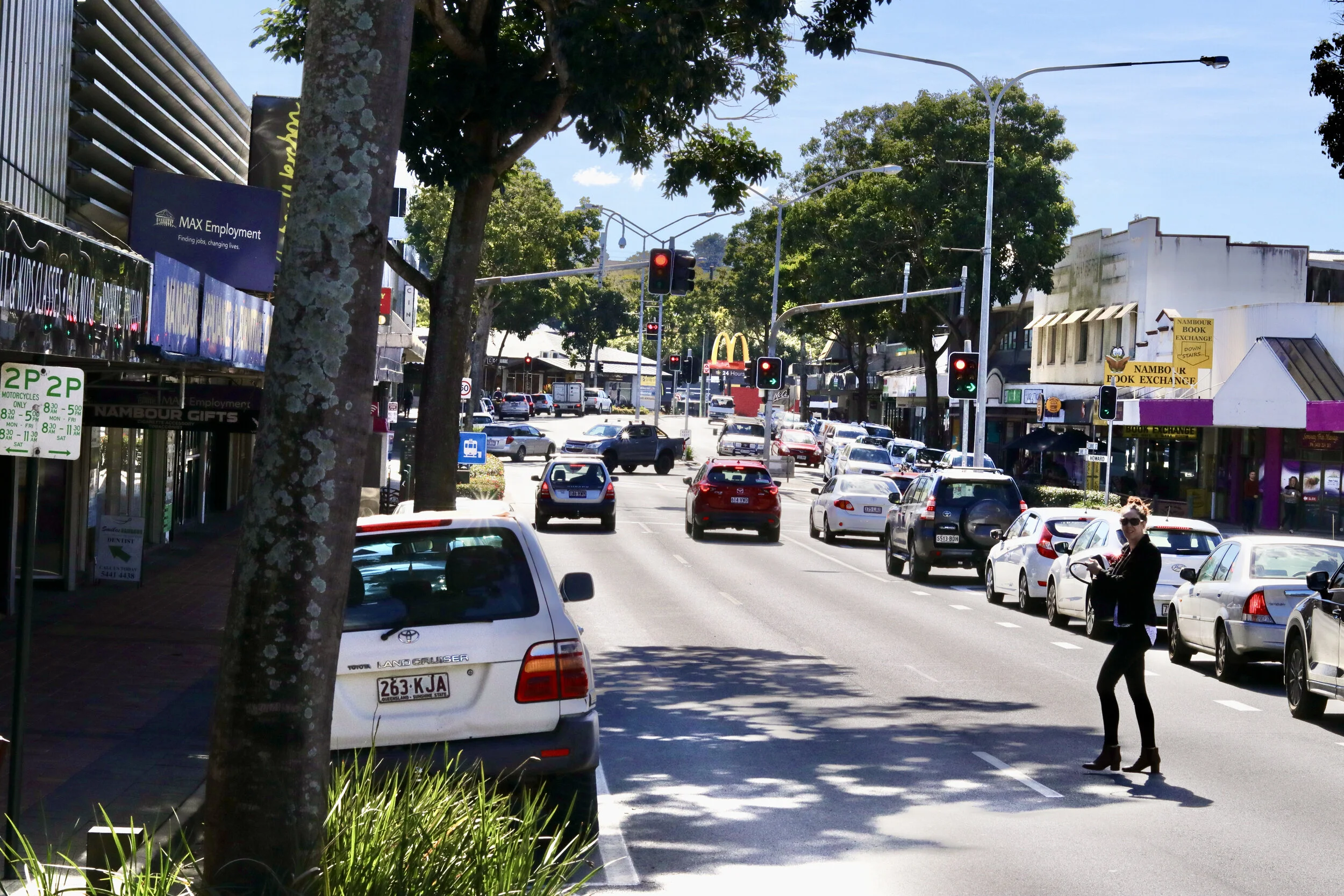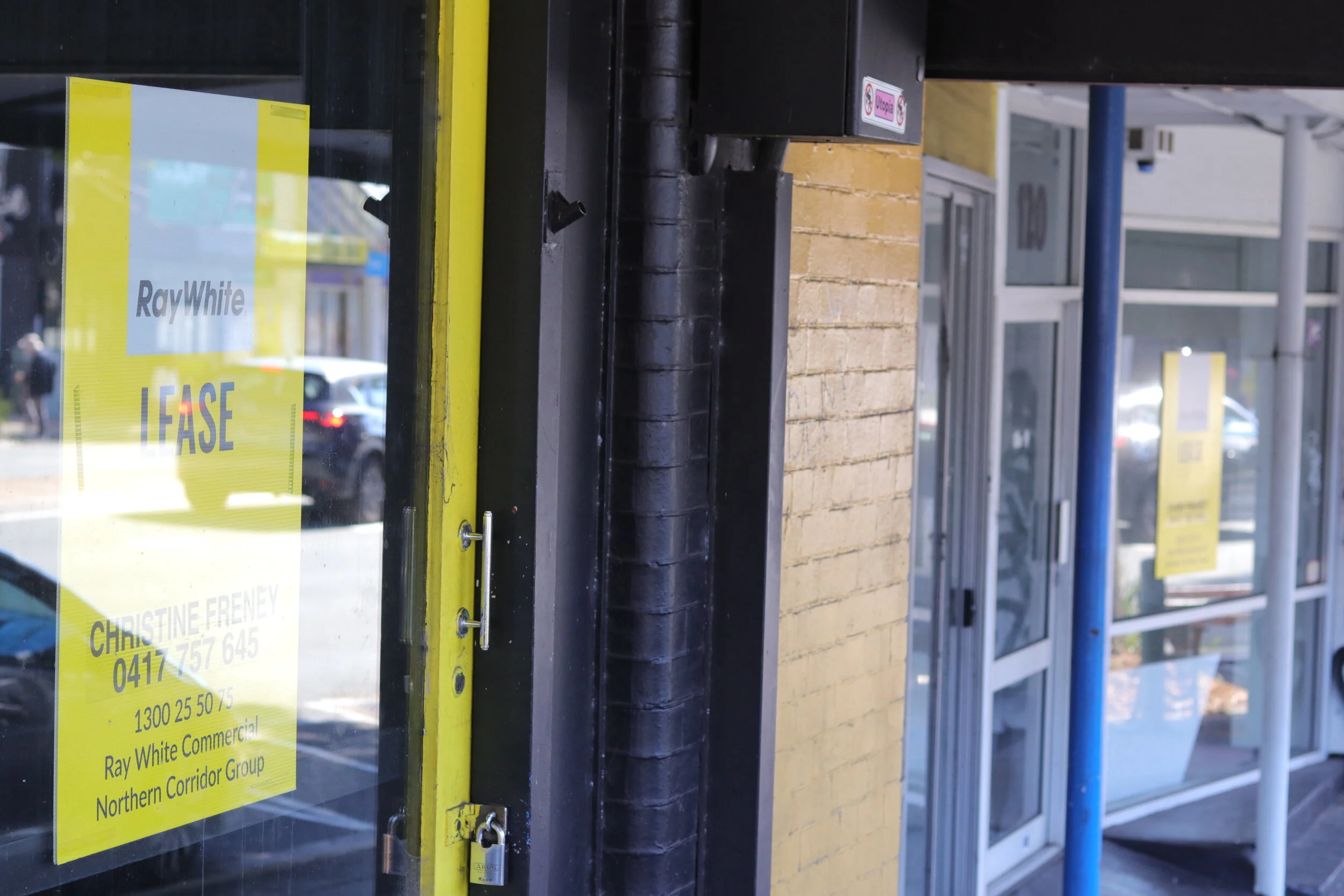We ask readers and leaders: What’s up with Currie Street?
Currie Street shops appear to be labouring under the weight of heavy through-traffic, high rents and parking issues.
The Gazette asked readers and community leaders why Currie Street had so many empty shops and what could be done about it. High rents, lack of parking and traffic flow issues have been highlighted as the critical elements holding back a main street that should be the jewel in the crown of a proud town. Instead empty shops give passers by a poor impression of a largely thriving town. Here’s some of what we were told ...
High rents a barrier, SEP entertainment precinct will help
Member for Nicklin Rob Skelton put the problem down to high rents preventing investment in town.
“From the businesses that already exist on Currie Street I am hearing that the rent/leases are too high,” Mr Skelton said.
“I’m not sure how it can be rectified, but I will be talking with the Sunshine Coast Regional Council, Chamber of Commerce, TramCo, ‘I am Nambour’ and other stakeholders in this area.”
Mr Skelton said revitalising the facades and reworking some of the spaces that weren’t currently tenanted into smaller offerings (with smaller rents) could help fill some of the empty shops.
He hoped the much-anticipated Special Entertainment Precinct (SEP) zoning would encourage entertainment into the CBD and provide a boost for Currie St.
“The SEP working group are another avenue to get some positive change as it involves the Sunshine Coast Regional Council. Both Cr David Law and myself are fully behind it. My overall view is that once we can agree on the by laws governing the SEP we can move forward.
“I have already forwarded the Brisbane City Council’s management plan of the Fortitude Valley SEP to the SCRC and am consulting with the relevant ministers to ensure that we have the right type of business in the area.
“The key is realising our zoning potential as an SEP. After that I am confident we will see a much more vibrant Main Street in our hub of the hinterland, Nambour. All levels of government and the community are united on this issue.”
People vs vehicles
Councillor David Law said during his 20 years living in Nambour he had witnessed many changes of activity along Currie Street. “However, like many towns with a major road through the centre, it is difficult to favour people over vehicles,” he said.
“With Currie Street being a four-lane highway carrying trucks and cars, I would like the traffic reduced in volume and speed. However we will need Department of Transport and Main Roads to be in agreement with such measures with this being a state-controlled road.
“I also believe that at the current time we have a unified position between community groups and all levels of Government that everyone who cares about Nambour is working hard together to continue to create a better Nambour for our whole community.”
Slow the traffic to lift the revival
Nambour Chamber of Commerce President Mark Bray said Nambour was definitely on the move but that slowing traffic through the main part of town should be investigated.
“My own personal view is that, until there is some type of traffic calming in Currie Street (particularly between Howard and Lowe Streets) it will be difficult to get that section to be vibrant during the day. I must admit during business hours I hate trying to park in a southerly direction on the eastern side of Currie Street. If and how traffic calming could occur – I’m not sure.”
Coordinate the lights
Reader Margie Gowty suggested coordinating the traffic lights to ease traffic. “It can take an age to drive from one end of Currie street to the other,” she said.
A business owner agreed saying in his experience traffic flowed best when the lights were out of order and flashing amber.
Reader Sande Bamford said she would have loved to see the empty shops filled with creatives using the space and giving passing tourists a reason to stop in Nambour as they followed the Tourist Drive.
Reader Pam Hughes said limited parking, outdated facades and a lack of major drawcards to attract tourists or shoppers were factors holding back Currie Street.
‘We need more mid-sized business’
C-Square general manager Tracy Martin said traffic flow was not conducive to easy movement from one side to another “and the tangle of the tram line etc at the Currie St/Mill St intersection doesn’t make it any easier”. She also pointed to a lack of mid-sized businesses looking to start up. “Perhaps it is because our (C-Square) Currie St tenancies are smaller that we have filled them quickly,” she said.
“Many mid-sized businesses that we have spoken to are not-for profits and are looking for support from Council to get started in town. Council-supported incentives have been proposed but not come to fruition, so those businesses go elsewhere.”
Ms Martin said there was a perception that parking was inconvenient. “Although we hope that the more flexible parking options at C-Square could help as people realise what is available.”
Outdated shop fronts
Resident Ro Latham said parking in the busy thoroughfare was a major issue. “When someone attempts to park, traffic has to come to a standstill and the continual fear is having another driver run into the back of you,” she said.
She said many shopfronts in Currie Street were outdated. “Shop fronts should be proud of their heritage and not hiding it behind dated refits from the 50, 60s and 70s,” she said. “And these shops need something vibrant and different in them, to offer a differentiated shopping experience to consumers and not another major chain pumping out the same goods that can be found in every other shopping precinct. Big call, I know, but this could be essential to get people out of their cars and to wander along Currie Street once again. The future Tram clientele should be offered some new and exciting experiences in the area, and particularly Currie Street.
“Too many shops have been vacant for too long. We’ve got out of the habit of even looking in the main street.”
High traffic, high rents, but high hopes
Rhonda Billett has operated her Uptown Hair Studio in Currie Street for 22 years. “I love my position on the street, Currie Street is fabulous,” she said. But: “I’d love to see the traffic slow down. Currie Street is a thoroughfare street, with hills. So people speed up. I get it. But sometimes people drive through so fast, they don’t get to notice or experience the businesses that are on the street and what is on offer.
“Being a State-governed street, it is a little different to other streets in Nambour that are overseen by council which is important to understand in all of this.
“A lot of shops on Currie Street are also have bigger floor mass. Bigger spaces mean bigger rent and it is sometimes not inviting for start-ups who cannot be certain of what income forecasts may be regarding future trade.
“Over the years, community groups I have been involved with, have chatted to various building owners, and we have to remember that some of these bigger buildings are owned by consortiums of investors. And unfortunately, the big empty building in Nambour, owned by these investors, is not of concern if the rest of the investment portfolio is performing.
“We do have some local investors and interstate investors however, who do own commercial property on Currie Street and these are the people who do what they can to accommodate filling empty shops as they understand the ‘big picture’ for Nambour and to these local investors we are grateful for their ongoing commitment to Nambour.
“I think that also, with the North side of Currie St, that the streetscaping should be a priority in getting completed, black bitumen paths are not fitting with the rest of the town and we should strive for this to be done for Currie Street to improve aesthetics. I have high hopes for the future, we have Sunshine Coast Council in full support of Nambour evolving from a commercial point of view with fabulous incentives on offer for developers who want to invest in developing Currie Street. We are looking forward to the day investors see the full potential of Currie street.
“Building smaller retail sized stores with residential living four stories high can be done, there are commercial sites on Currie Street for sale as I type this, we just desperately need to find someone to invest, who shares the vision and takes the lead on being “first in” for a town that wants to thrive and move forward.”
Heavy traffic, lack of parking
Marlene Hoskin said she found it difficult to park outside shops because of the heavy traffic.
“That is only if I could find a vacant one,” she said. “I am at the stage in life where I don’t want to walk far or up a hill for a quick purchase. “The Commonwealth Bank attracted a lot of foot traffic when it was situated in the block between Low and Howard Street as did Target and KMart. I am a believer in parking metres.”
Empty shops a tax write-off
Many people The Gazette spoke to referred to counter-productive incentives for some landlords to maintain empty shops (for tax write-off purposes) rather than lowering rents to gain tenants.
A property owner who preferred not to be named said empty tenancies meant lower income which could be used as a tax buffer.
“If your income is less than it costs to run the building plus depreciation, then you will be making a tax loss, though perhaps not actually a cash loss, depending on how much interest you pay on any loans etc.
“If you have other investments you can balance out those tax losses against tax to be paid on profits earned elsewhere. So it is no big deal to have that loss. So you may well not care that you have lots of empty tenancies and not much income.”
Incentive to keep rents high
The property owner also said landlords had a counter-productive incentive to keep rents perhaps artificially high.
“If you lock in lower rents, you lower the value of your building. Then, if you have your building valued — banks will want this done regularly — filled tenancies are valued based on the rent they attract. Vacant tenancies are valued at a market rent for the area. The more you drop your rents, the less your building is valued. And if you drop all your rents, then that creates downward pressure on market rents in the area generally and that also drops the value of everyone’s buildings.
“When loans have conditions such as only lending 80 percent of the building value, if your building value drops below 80 percent of your loan, then you can find that you have breached your loan covenants. Not very nice at all.”
• Have your say on Facebook @SunshineValleyGazette











